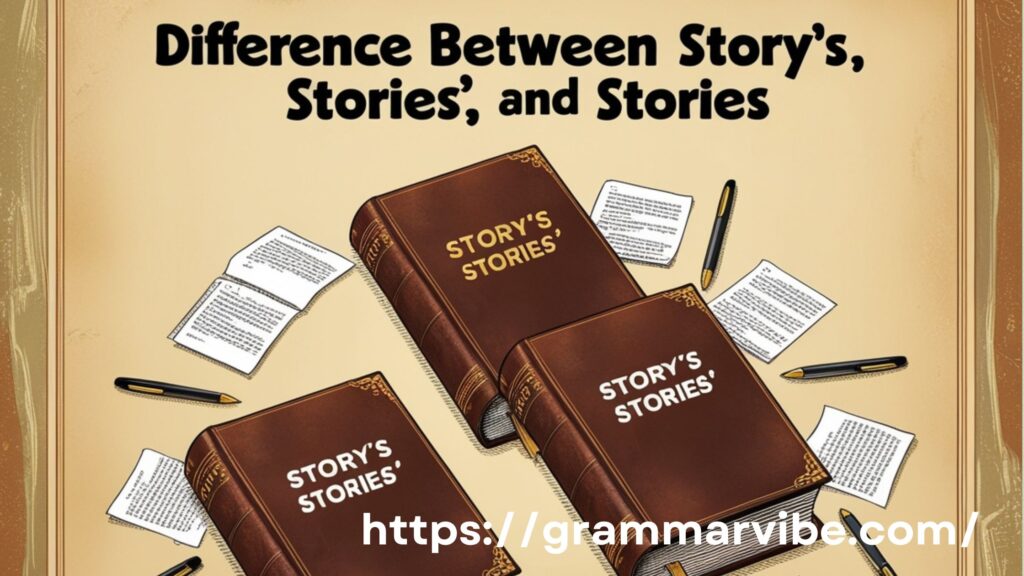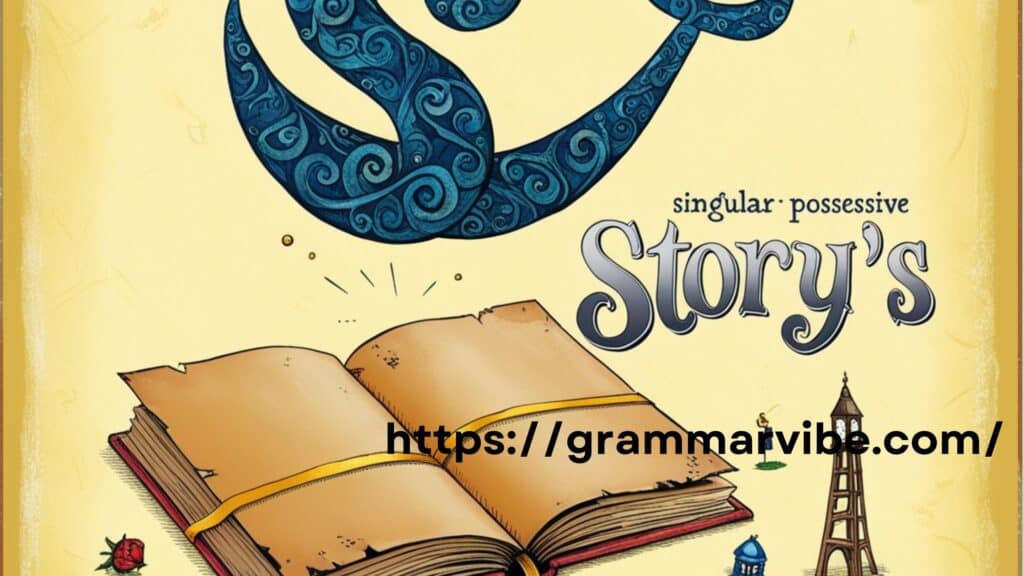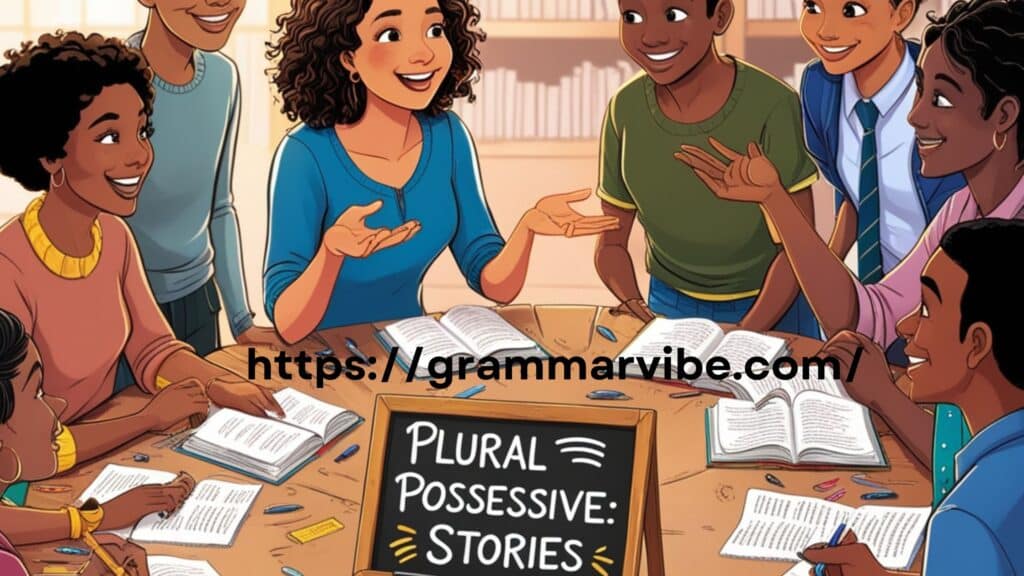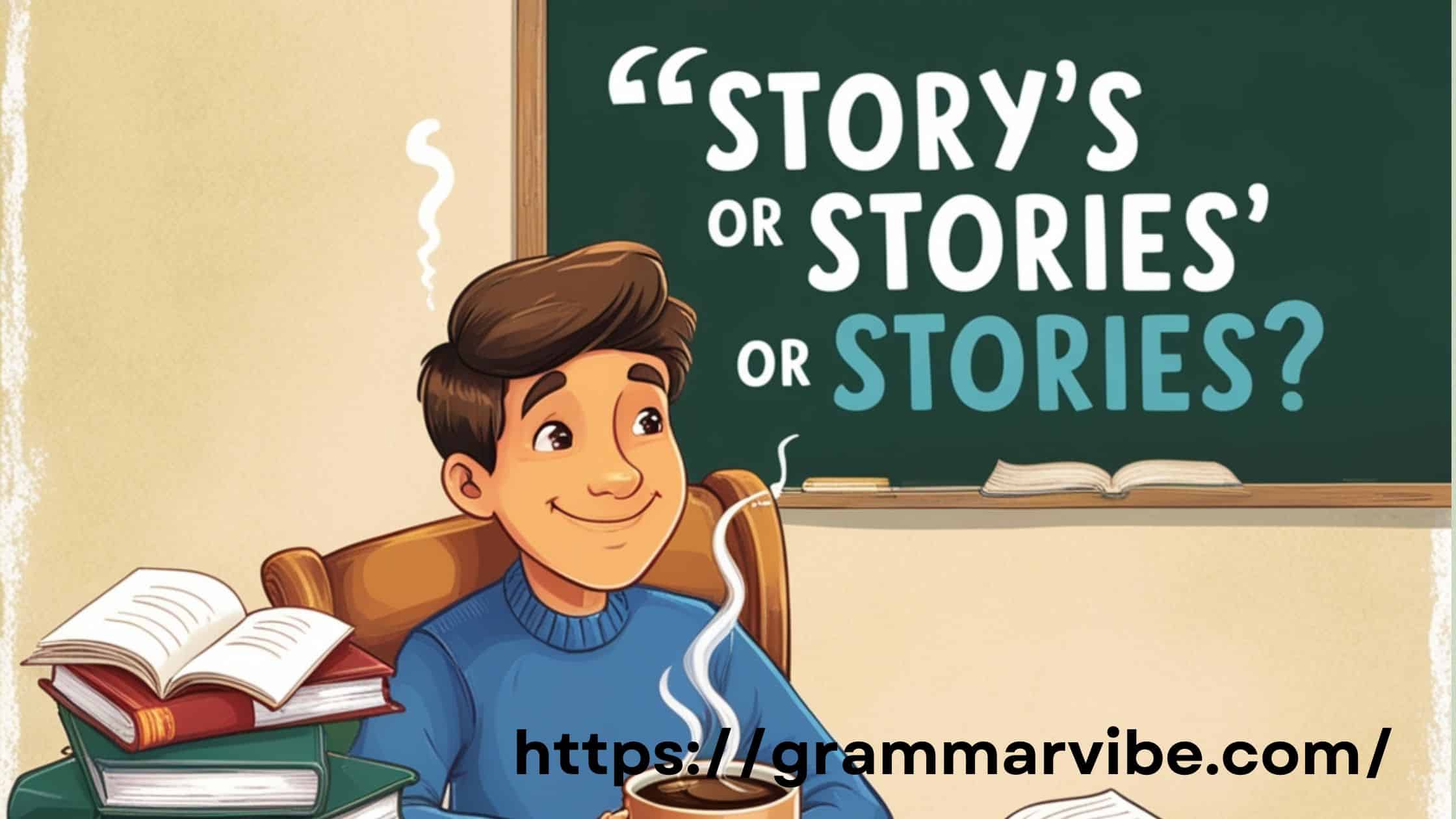Understanding the proper use of possessive forms and plural forms is essential for anyone looking to master English grammar. Words like story’s, stories’, and stories can cause confusion, particularly because they involve not just possession, but also the difference between singular and plural nouns.
This article will break down each form, explain the possessive grammar rules, and provide example sentences to clarify their proper usage. Whether you’re a student, a teacher, or a writer, these grammar tips for possessive forms will help ensure your writing is correct.
What is the Difference Between Story’s, Stories’, and Stories?

Let’s start by looking at the basics. Story’s (with an apostrophe before the “s”) is the singular possessive form. It means something belongs to or is associated with a single story. On the other hand, stories’ (with the apostrophe after the “s”) is the plural possessive form, meaning something belongs to or is associated with multiple stories. Finally, stories (with no apostrophe) is just the plural form of story, referring to more than one narrative but without indicating possession.
You might also like Business’ or Business’s
Singular Possessive: Story’s

When we use story’s, we’re talking about something that belongs to one story. This is the singular possessive form. An apostrophe followed by an “s” (‘s) indicates possession for singular nouns. For example:
- The story’s moral was profound and left the readers thinking about their own lives.
- The author revealed the story’s characters in a unique way, giving each one a detailed background.
- The story’s ending was unexpected, shocking everyone who read it.
In these example sentences, the word story’s tells us that the moral, characters, and ending all belong to a single story. The possessive apostrophe usage is key in these cases to show that connection.
You might also like Community’s or Communities’ or Communities
Plural Possessive: Stories’

In contrast, stories’ is the plural possessive form. This means that the noun is plural, and the apostrophe after the “s” shows possession. For example:
- The stories’ messages were diverse, each one offering different life lessons.
- After reading the collection, I couldn’t stop thinking about the stories’ morals.
- The teacher appreciated the stories’ creativity, as every student wrote something unique.
Here, we’re talking about multiple stories, and the apostrophe placement (after the “s”) tells us that these are things belonging to multiple stories.
You might also like Student’s or Students’ or Students
Plural Form: Stories

The word stories is simply the plural form of story. This form refers to more than one story without showing possession. For example:
- I’ve read many fascinating stories from around the world.
- Stories told around campfires have a special charm.
- Children love stories that involve adventure and mystery.
In these sentences, we’re discussing more than one story without needing to indicate ownership or possession.
You might also like Luis’ or Luis’s
Understanding Possessive Grammar Rules
To get a good grasp of possessive forms, it’s essential to understand how possessives work in English. The rules are straightforward:
- Singular nouns take an apostrophe + “s” to show possession. This applies even if the noun ends in “s”. For example, the story’s ending (the ending belongs to one story).
- Plural nouns that end in “s” take an apostrophe after the “s” to show possession. For example, the stories’ themes (the themes belong to multiple stories).
- Irregular nouns that don’t end in “s” (like “children” or “women”) take an apostrophe + “s” to show possession, even when plural. For example, the children’s stories (the stories belong to multiple children).
You might also like Wife’s or Wives’
Example Sentences with Singular and Plural Possessives
Here are some additional example sentences that highlight both singular and plural possessive forms:
- The writer’s bestseller was a gripping thriller that everyone loved. (Singular possessive: one writer)
- The writers’ bestsellers flew off the shelves during the holiday season. (Plural possessive: more than one writer)
- The reader’s feedback was valuable for improving the book. (Singular possessive: one reader)
- The readers’ stories shared common themes of love and loss. (Plural possessive: multiple readers)
These examples show how the placement of the apostrophe changes depending on whether the noun is singular or plural. Understanding this distinction is essential for mastering sentence structure in English.
You might also like Witness’ or Witness’s or Witness
The Plural Suffix “-ies”
The plural of many nouns in English is formed by adding -ies to the end of words that end in a consonant + “y”. This is known as the plural suffix “-ies”. For example:
- Story becomes stories.
- Category becomes categories.
When forming the plural of words like “story”, the “y” is dropped and replaced with “ies”, but no apostrophe is used unless it’s showing possession. This is a crucial rule in English possessive grammar.
Common Mistakes with Possessive Apostrophe Usage
A frequent mistake that people make involves confusing the placement of the apostrophe. For example, people might mistakenly write story’s when they mean stories’, or they might forget the apostrophe altogether. Here are a few reminders to avoid these pitfalls:
- Don’t use story’s if you’re talking about more than one story—that form is only for the singular possessive.
- Don’t forget the apostrophe in stories’ when you want to show possession for multiple stories.
- Avoid placing an apostrophe in the word stories when it’s just the plural form with no possession involved.
Story Rephrasing and Possession in Context
Rephrasing sentences that involve possession can help clarify meaning. For example:
- The story’s characters can be rephrased as “the characters of the story” to avoid the possessive form if it feels too formal.
- Similarly, the stories’ lessons can become “the lessons in the stories” to shift away from the possessive.
Using different sentence structures like these offers a way to keep your writing varied and engaging.
Conclusion: Mastering Possessive Forms in English Grammar
Whether you’re discussing a single story or multiple stories, understanding the rules for possessive forms is key to using these terms correctly. Remember that story’s indicates something belonging to one story (the singular form), while stories’ shows possession for more than one story (the plural possessive). Finally, stories refers simply to multiple stories, with no possession involved.
By mastering these distinctions, you’ll avoid common mistakes in English grammar and improve the clarity and professionalism of your writing. Whether you’re talking about a story’s moral, stories around campfires, or the writers’ bestsellers, knowing the correct form will ensure your message is clear and grammatically sound.
The next time you’re writing and you find yourself wondering whether to use story’s, stories’, or stories, refer back to these grammar tips for possessive forms to ensure you’re using the right form for the situation.
Table summarizes the singular, plural, and possessive forms:
| Word | Type | Form | Example |
|---|---|---|---|
| Story | Singular | Singular Form | I read an interesting story. |
| Stories | Plural | Plural Form | He has written many stories. |
| Story’s | Singular Possessive | ‘s (Possessive) | The story’s ending was surprising. |
| Stories’ | Plural Possessive | s’ (Possessive) | The stories’ morals were inspiring. |
| Writer’s | Singular Possessive | ‘s (Possessive) | The writer’s bestseller was a hit. |
| Writers’ | Plural Possessive | s’ (Possessive) | The writers’ bestsellers were sold out. |
| Reader’s | Singular Possessive | ‘s (Possessive) | The reader’s feedback was helpful. |
| Readers’ | Plural Possessive | s’ (Possessive) | The readers’ stories were fascinating. |
| Story’s Characters | Singular Possessive Compound | ‘s (Possessive) | The story’s characters were well-developed. |
| Stories’ Messages | Plural Possessive Compound | s’ (Possessive) | The stories’ messages were thought-provoking. |
| Story’s Moral | Singular Possessive Compound | ‘s (Possessive) | The story’s moral was clear and insightful. |

Kyren Paul is an experienced blogger and the creative mind behind “Grammar Vibe.” With a passion for the nuances of English grammar, he brings clarity and insight to everyday language topics, making grammar accessible and engaging for readers of all levels.











Leave a Comment